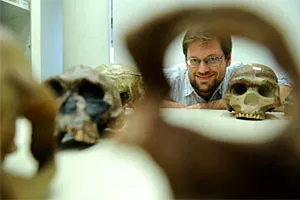
Darwin Day lecture: Bones, Stones and DNA
How do you honour the birthday of the leader of evolutionary thought? By taking a long look at our ancestral family tree. Tonight at U of T Mississauga, Café Scientifique hosts “Bones, Stones and DNA,” a lecture by palaeoanthropologist Bence Viola. The event celebrates Charles Darwin’s 208th birthday and commemorates the importance of Darwin’s evolutionary theories.
Viola lectures on human evolution at UTM, and is a research fellow at the Max-Planck-Institute for Evolutionary Anthropology. In his research, Viola uses archaeological and genetic data to examine the biological and cultural interactions between various hominin groups who lived over 130,000 years ago.
In his lecture tonight, Viola will discuss how fieldwork and genomic breakthroughs have led to a major changes to our understanding of Neanderthals. The group was previously thought to be without language or rituals, however new archeological discoveries are shifting those theories. “We are learning that Neanderthal behaviour was much more complex that we had thought. There is more evidence that they used bird feathers, shells and pigments to create ornaments like pendants,” Viola says. “The view of Neanderthals is changing. It’s a pretty exciting time.”
Genetic sequencing of hominin remains has led to further exciting discoveries, Viola says. Sequencing of the Neanderthal genome shows that much of the world’s present-day population carries a small amount of Neanderthal DNA. With the exception of direct African decedents, most of the world is can trace up to two per cent of their genetic makeup to Neanderthal ancestors. Present-day aboriginal populations in Australia, New Guinea and Tibet can trace three to five per cent of their genetic makeup to Siberia’s Denisvoan population—a genetically distinct group discovered in 2010 and known as the “Asian Neanderthals”, who coexisted and interbred with Neanderthals for about 5,000 years.
“Those genetic traces may not seem like a lot, but it can have an important effect on how modern humans adapted to new pathogens, or to life at high altitudes,” Viola says. For instants, an allele related to Denisovan DNA is present in Tibetan populations, where it contributes to higher birth weights, an adaptation to living in the Himalayas.”
Viola is intrigued by the intersection of genetics and archeology. He is going to Kyrgyzstan this fall, where he will continue genetic research on human remains thought to be over 150,000 years old. Viola hopes the discovery will yield answers about when humans arrived in Central Asia. “There’s so much we don’t know about yet.”
Attend Bence Viola’s talk: Thursday, February 12 in the Davis Building, DV2045, 7 to 9 pm.
